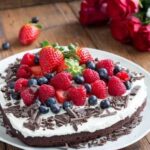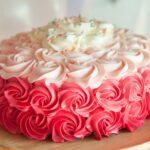A cake decorating bag is an essential tool for anyone looking to achieve professional-looking cakes. With its versatility and control, it provides a seamless way to apply various designs and patterns onto the surface of a cake. Whether you are a professional baker or someone who simply loves baking as a hobby, understanding how to assemble a cake decorating bag is crucial in elevating your cake decorating skills.
Using a cake decorating bag allows for precise control over the application of frosting or icing, resulting in clean lines and intricate designs. It enables you to create beautiful borders, flowers, letters, and other decorative elements with ease. The ability to switch out different tips also offers endless possibilities in terms of design options, allowing you to experiment and create unique decorations that reflect your personal style.
To begin assembling a cake decorating bag, it’s important to understand its different components. The main components include the bag itself, couplers, and various tips. Each component plays a specific role in the assembly process and contributes to the overall functionality of the bag. By familiarizing yourself with these components, you’ll be able to assemble your own bag effortlessly.
In this article, we will guide you through the step-by-step process of assembling a cake decorating bag. We will discuss the different components involved and provide tips on where to find them. Additionally, we will cover troubleshooting common assembly issues so that you can address any problems that may arise during the process. So let’s get started and learn how to assemble a cake decorating bag to enhance your cake decorations.
Understanding the Different Components of a Cake Decorating Bag
A cake decorating bag is an essential tool in creating professional-looking cakes, as it provides versatility and control in applying various designs and patterns. To fully understand how to assemble a cake decorating bag, it is important to familiarize yourself with its different components.
The main components of a cake decorating bag include the bag itself, couplers, and various tips. The bag is typically made of either plastic or reusable fabric, and it serves as the vessel for holding the frosting or icing. Couplers are used to easily change out different tips without having to empty the bag completely.
They consist of a base and a ring that secures the tip in place. Finally, there are a wide variety of tips available for different designs and patterns, such as round tips for outlines and writing, star tips for borders and rosettes, and petal tips for flower designs.
Each component of the cake decorating bag works together to create beautiful decorations. The bag holds the frosting or icing securely while allowing for easy pressure control. Couplers provide stability to the tip, allowing for precise piping movements without worrying about them becoming loose. Tips determine the shape and size of the decoration being piped onto the cake.
Understanding how these components work is crucial in assembling a cake decorating bag correctly. It ensures that you have everything you need to achieve your desired design and that your equipment functions properly throughout the entire process.
Gathering the Necessary Supplies
To assemble a cake decorating bag, it is important to gather all the necessary supplies. Having the right tools and materials will ensure a smooth and successful cake decorating experience. The following are the essential supplies needed for assembling a cake decorating bag:
- Piping bag: This is the main component of a cake decorating bag. It is typically made of strong, flexible plastic that can withstand the pressure of piping frosting or icing onto cakes.
- Couplers: Couplers are used to attach different tips onto the piping bag. They allow for easy tip changes without having to empty and refill the bag. Couplers consist of a base and a ring that secure the desired tip in place.
- Tips: Cake decorating tips come in various shapes and sizes, each designed to create different decorative patterns and designs on cakes. Some common types of tips include round, star, petal, leaf, and specialty tips.
- Decorating tools: In addition to the main components mentioned above, there are some additional tools that can be helpful for assembling a cake decorating bag. These tools include scissors (for cutting the piping bag), a spatula or scraper (for filling the bag with frosting), and an icing smoother (for achieving smooth and even frosting application).
These supplies can be found at specialty baking stores, craft stores, or even online retailers that cater to baking enthusiasts. When purchasing these supplies, it is important to consider factors such as quality and durability to ensure longevity in use.
| Supply | Description |
|---|---|
| Piping Bag | A strong and flexible plastic bag used for piping frosting or icing onto cakes |
| Couplers | Components used to attach different tips onto the piping bag, allowing for easy tip changes |
| Tips | Various shapes and sizes of tips used to create different decorative patterns and designs on cakes |
| Decorating Tools | Additional tools such as scissors, spatula or scraper, and icing smoother that aid in assembling and using the cake decorating bag |
By ensuring that all these supplies are readily available, aspiring cake decorators will be well-prepared to assemble their own cake decorating bags and start creating professional-looking designs on their cakes.
Preparing the Piping Bag
To assemble a cake decorating bag, you’ll first need to prepare the piping bag itself. This step ensures that your bag is clean, the right size, and cut neatly for a professional finish.
- Choose the Right Size: Before preparing your piping bag, select the appropriate size for your project. Smaller bags are ideal for detailed work or writing, while larger bags are better suited for filling and covering larger areas of the cake. Keep in mind that you can always refill a smaller bag if needed.
- Clean the Piping Bag: It’s important to clean your piping bag before each use to prevent any residue or flavors from previous decorations transferring onto your new creation. Wash it thoroughly with warm soapy water and allow it to air dry completely.
- Cut the Bag: Once cleaned and dry, you’ll need to cut the tip of the piping bag. Hold the bag with one hand and make a small diagonal cut at the tip using a sharp pair of scissors. The size of the opening will depend on the type of design you want to achieve – a smaller cut for fine lines and details, or a larger opening for broader strokes.
- Neatness Matters: To ensure a neat and professional look, hold the scissors at an angle while cutting instead of straight across. This will result in a cleaner edge and minimize any jagged or uneven cuts.
- Test It Out: After cutting, test out your piping bag by inserting your desired tip (covered in section 5) into the end of the bag where you made the cut. Squeeze gently to see if icing comes through smoothly without any resistance or leaks. If necessary, adjust your cut accordingly until you achieve the desired flow.
By following these steps to prepare your piping bag properly, you’ll be ready to take on any cake decorating challenge with confidence.
Sources:
- Gibbs Smith Baking & Decorating Tips.
- Wilton Cake Decorating Basics Guide.
Adding the Coupler and Tip
To achieve professional-looking cake decorations, it is important to understand how to properly add the coupler and tip to your cake decorating bag. The coupler serves as a connector between the bag and the tip, allowing for easy tip changes without having to empty the bag of frosting or icing. Here are the steps to effectively add the coupler and tip to your cake decorating bag:
- Attach the Coupler: Begin by cutting off a small portion of the piping bag’s pointed end. This cut should be big enough for the base of the coupler to fit through snugly. Insert the threaded end of the coupler through the hole you’ve created, ensuring that it is completely inside the bag.
- Secure with a Ring: Once the threaded end of the coupler is inside the bag, screw on a ring attachment from outside of the bag over it. This will secure and hold everything in place while you decorate your cake.
- Choose Your Tip: Select a decorating tip that matches your desired design or pattern. There is a wide variety of tips available, each creating different shapes or textures in your decorations. Slide your chosen tip onto the exposed threaded end of the coupler from inside of the piping bag.
- Tighten with a Second Ring: After attaching your desired tip, screw on another ring attachment from outside of the bag over it. This will hold both the tip and coupler securely in place while you decorate.
Once you have successfully added your coupler and tip to your cake decorating bag, you are ready to fill it with frosting or icing and start creating beautiful designs. Remember, practicing with different tips and experimenting with different techniques will help improve your skills and allow you to create unique decorations for any occasion.
For troubleshooting common issues during assembly, such as leaking tips or unstable connections, refer back to Section 7 where we offer solutions and tips for resolving these problems effectively. With a bit of practice and experimentation, you’ll soon be on your way to achieving stunning cake decorations that will impress your friends and family.
Filling the Bag with Frosting or Icing
Once you have assembled your cake decorating bag, the next step is to fill it with frosting or icing. Properly filling the bag ensures that you have enough material to work with while also maintaining control over the piping process. Here is a step-by-step guide on how to fill your cake decorating bag:
- Choose the right consistency: Before filling the bag, make sure that your frosting or icing has the right consistency for piping. If it is too thin, it may result in messy and uncontrolled piping. If it is too thick, it may be difficult to pipe smoothly. Adjust the consistency by adding more powdered sugar to thicken or small amounts of liquid (such as milk or water) to thin out the frosting.
- Fold down the top: Begin by folding down about 2 inches of the top of your piping bag. This will create a stable base for filling and prevent any frosting from leaking out of the top.
- Fill half-full: Hold open the bag with one hand, while using a spatula or spoon to scoop frosting into it with your other hand. Fill only up to halfway full initially, as an overly full bag can be hard to handle and may lead to unwanted messes.
- Squeezing technique: To push all of your frosting towards the tip, use your dominant hand to squeeze and twist the top of the bag tightly closed while applying pressure downwards. This will ensure that all of your frosting is pushed towards one end for easy piping.
- Finishing touches: Once you have filled your cake decorating bag with enough frosting or icing, release any air bubbles by gently tapping or squeezing from the open end upwards until they escape out of the top.
It’s important to note that if you are working with multiple colors or flavors, you will need separate bags for each type and fill them one at a time following the steps above. Additionally, you may find it helpful to place your filled bag in a tall glass or container for support while you are decorating.
Filling the cake decorating bag is an essential step that sets the stage for beautifully piped designs and patterns. The proper technique and consistency of frosting can greatly impact the end result, so take your time and practice to achieve the desired outcome.
Troubleshooting Common Assembly Issues
Assembling a cake decorating bag can sometimes come with its fair share of challenges. In this section, we will address some common issues that may arise during the assembly process and provide helpful solutions to ensure a smooth and successful experience.
One of the most frustrating problems that decorators face is when their piping bag starts to leak. This can happen if there are any small holes or tears in the bag, or if the frosting is not properly secured inside.
To prevent leaking, it is crucial to check the bag for any damage before filling it with frosting. If there are any holes or tears present, simply cut off the damaged portion and securely tie a knot at the end of the bag to seal it.
Another common issue is unstable tips that keep falling off while decorating. This can be caused by not properly attaching the coupler and tip. To ensure a stable connection, make sure to tightly screw on the coupler onto the piping bag. Additionally, before attaching your chosen tip onto the coupler, give it a gentle twist to secure it in place.
If you find that your frosting isn’t coming out smoothly or consistently, it could be due to an issue with nozzle blockage. This usually happens when tiny pieces of dried icing clog up the tip’s opening. To fix this problem, remove your tip from the coupler and use a toothpick or small brush to gently clear out any obstructions from both ends of the tip.
By troubleshooting these common assembly issues, you’ll be able to overcome any obstacles and achieve professional-looking cake decorations every time. Remember that practice makes perfect, so don’t get discouraged if you encounter difficulties along the way. With patience and persistence, you’ll soon become an expert at assembling and using cake decorating bags effectively.
Practice and Experimentation
Mastering Cake Decorating Techniques
In order to achieve beautiful cake decorations, it is essential to dedicate time to practice and experimentation. Decorating a cake is an art form that requires not only the right tools but also a certain level of skill and technique. By continuously practicing and experimenting with different designs, frosting consistencies, and tips, you can enhance your cake decorating skills and create stunning creations.
Trying Different Tips
One way to improve your cake decorating skills is by trying out different tips. Tips come in a variety of shapes and sizes, each producing unique designs. For example, a round tip can be used for creating dots or outlines, while a star tip is perfect for making rosettes or shells. By experimenting with different tips, you can discover which ones you prefer using and get comfortable with their techniques.
When trying out new tips, it’s important to consider the consistency of your frosting or icing. Thicker frostings like buttercream work best with larger tips, while thinner icings are more suitable for smaller tips. It may take some trial and error to find the perfect combination of tip size and frosting consistency that works best for your desired design.
Exploring Design Options
Another aspect of practice and experimentation in cake decorating is exploring various design options. Once you have mastered basic techniques with different tips, you can start getting creative with your designs. Try piping flowers, leaves, or intricate patterns in different colors to add visual interest to your cakes.
Additionally, you can experiment with different textures by using various techniques such as ruffling or basket-weaving. These techniques will give your cakes an added dimension and make them stand out.
Remember that practice makes perfect when it comes to cake decorating. Don’t be afraid to make mistakes or try something new. By continuously practicing and experimenting with different techniques and designs, you will gradually master the art of cake decorating and create beautiful cakes that will impress your friends and family.
Conclusion
In conclusion, assembling a cake decorating bag is a crucial step in achieving beautiful and professional-looking cake decorations. By understanding the different components of a cake decorating bag and gathering the necessary supplies, you can have the versatility and control to create various designs and patterns on your cakes.
Preparing the piping bag properly, adding the coupler and tip, and filling it with frosting or icing are all essential steps that should be followed carefully. Troubleshooting common assembly issues may arise during the process, but with the right solutions and tips, these problems can be easily resolved.
However, it is important to remember that mastering cake decorating techniques requires practice and experimentation. Don’t be afraid to try different tips, frosting consistencies, and designs to enhance your skills. With time and dedication, you will be able to create stunning cake decorations that will wow your friends and family.
So why wait? Gather your supplies, assemble your own cake decorating bag, and start experimenting with various designs and patterns. By following the steps outlined in this article, you will be well on your way to creating beautiful cakes that are sure to impress everyone who sees them. Happy decorating.
Frequently Asked Questions
How do you set up a cake decorating bag?
To set up a cake decorating bag, begin by selecting the desired tip for the design you want to create. Hold the bag with one hand and fold down the top half of the bag, forming a cuff. Then, using scissors, cut a small opening at the pointed end of the bag.
Insert the chosen tip into this opening and push it gently until it reaches the end of the bag. Once inserted, unfold the cuff over the outside of the nozzle to secure it in place. Finally, twist and hold the top half of the bag tightly to prevent any icing from leaking out while filling.
How do you set up an icing piping bag?
Setting up an icing piping bag may vary depending on whether you are using a disposable or reusable bag. For a disposable bag, start by cutting off about an inch from the tip of the bag with scissors to create an opening for your nozzle. If you are utilizing a reusable one, attach your desired decorating tip onto the interior coupler or adaptor before inserting it through an existing small hole at one end of the pastry bag.
Usually, reusable bags have metal rings that can be twisted onto securely fasten everything together. Next, fold down about one-third of its length from the top to create a cuff-like shape while leaving plenty of space within for adding icing.
How do you attach a nozzle to a piping bag?
Attaching a nozzle to a piping bag is relatively straightforward once you have prepared both elements. After deciding on which nozzle you want to use for your cake decorating project, make sure your piping bag is set up and ready with proper openings or adaptors if necessary (refer to question 2). Take your chosen nozzle and insert it into either an open-end or adaptor-equipped piping bag until it feels snugly fit at its larger base inside.
Gently push it all way through until only its narrowest part remains visible outside of your piping bag’s opening. The coupling mechanism often requires twisting or securing rings on reusable bags for additional stability and prevention against icing leakage.

Welcome to my blog about home and family. This blog is a place where I will share my thoughts, ideas, and experiences related to these important topics. I am a stay-at-home mom with two young children. I hope you enjoy reading it! and may find some helpful tips and ideas that will make your home and family life even better!





